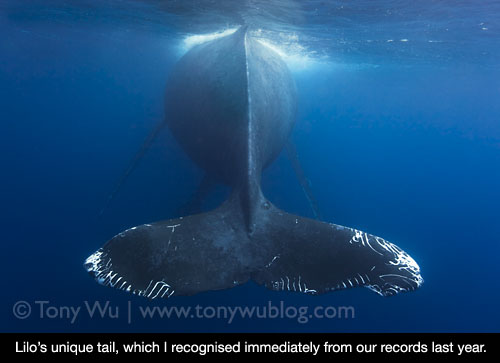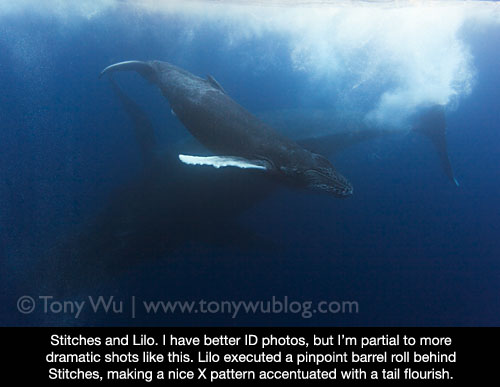Well...it looks like the effort that I put into being methodical about calf observations in Tonga has paid off.
On Tuesday morning, we came across a mother and calf pair near Sisia. The water was murky and skies not so great, but the mom was calm and calf playful. With the limited visibility, we took it slow, giving the whales time to observe us, assess our presence, and finally decide that we were perfectly harmless.
Once settled, mommy rested at or near the surface while the calf swam laps around her, twirled in mid-water, came up for breaths, paused to stare at us, splash and squeal a bit...do general humpback whale calf stuff.
Upon seeing the mother's tail, I immediately thought, "Hmmm, this looks familiar.", recalling a fluke that I had seen last year with a calf. "It would be pretty cool if this were the same whale." I continued in my head as I watched the pair of resting cetaceans. But I'd heard many times that because of the enormous energy investment required to give birth and then raise a calf, humpback whale females are only able to have babies every two to three years.

Nevertheless, the thought kept nagging at me, so as soon as we got back to land, I checked my calf summary PDF file from last year, and sure enough...she was there!
As it turns out, the mother we saw yesterday had a calf during the 2008 season also, which means she's been here two years in a row and she's had babies in both years. We photographed mom and baby together in 2008, assigning the name "Scratches" to the baby, because it was easy to identify the mom from the unique scratch-like markings on her tail.
Those same markings gave her away again.
To match the name Scratches, we gave the 2009 baby whale the name "Stitches". And because the mother is obviously a repeat visitor to these islands, we named her "Lilo" (If you have kids, you'll recognise the reference to Lilo and Stitch.) in case we see her again in the future.
Of interest, Scratches and Stitches share at least one similarity in appearance. Both have white-edged pectoral fins.
To the best of my knowledge, this is the first time that a repeat-visit to Vava'u by a humpback whale has been photographically documented. I know that there are many anecdotal reports of repeat sightings, but I don't think there's been any visual documentation. If I'm wrong and there's a previous precedent someone knows of, please let me know.
And of course, I'm thrilled beyond words to document that Lilo has had two babies in as many years, just one season after starting to keep a methodical record of calf sightings here...makes the long hours and lost sleep worthwhile.

Soon after getting back to land, I emailed my friend and cetacean expert Dr Adam Pack in Hawaii about whether there's been previous documentation of a female having two calfs in two consecutive years. According to Adam, he and others have documented a few examples, though the accepted average frequency for humpbacks having babies is two to three years apart between births.
He also pointed out the having two babies in two years might be a good thing, but it also might not. What we don't know is what happened to Scratches (the 2008 baby). In theory, Lilo should have raised Scratches to the point of independence prior to giving birth to Stitches.
It's possible that she did, though given the size of Scratches when we photographed mom and baby last year, I'm not so sure there was sufficient time. It's also possible mom and baby were separated after I saw them, or that something happened to the baby. We'll probably never know for sure.
And finally, after studying all our images from Tuesday, my friend Takaji Ochi and I believe that Stitches is female. I hope I'm around when Stitches has a baby.